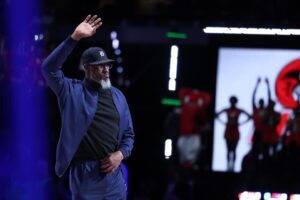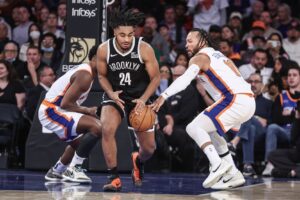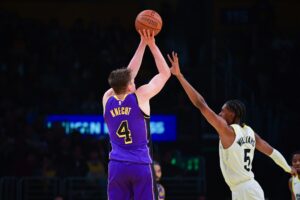RJ Barrett looked like a budding star with the Raptors. In 32 games with his hometown club, Barrett put up career highs across the board. Averaging 22 points 6 rebounds, and four assists while shooting 55% from the field, 39% from three, and a shocking 63% from the charity stripe or 61% true shooting. What drove this increase in production across the board and can he keep it up next season?
Homecoming Success: RJ Barrett’s Improved Play With Toronto
Different Offensive Styles
The Toronto Raptors and New York Knicks play nearly polar opposite play styles. The Raptors’ offensive game plan under Coach Darko has been about quick decisions, ball movement, and pushing the pace. The Knicks under Thibs run a much slower iso-heavy offense that sees the ball in Jalen Brunson’s or Julius Randle’s hands (when healthy) 80% of the time. A perfect way to highlight this is by looking at both teams’ pace of play. Following the OG for RJ/IQ deal the Raptors shot up to the fifth fastest pace or 100 possessions per 48. The Knicks on the other hand rank dead last in pace with 94 possessions per 48.
RJ Barrett thrives in quicker-paced offense systems that love to get out in transition or run-cutting actions in the half-court. That is the very base of Coach Darko’s offense system. The match between coach and player couldn’t be much better.
Maximizing RJ Barrett’s Strengths
Barrett in transition is nearly an unstoppable force, using his strength to bully his way to the rim and finish through contact. In the half court, Barrett’s great off-ball movement shines with the Raptors. Barrett does an excellent job slipping out of his defender’s view and getting to open spots along the three-point line. He has great timing when it comes to when to get open from three, often waiting for his teammates to finish their drive before flashing to an opening as a release valve. RJ uses his skill for reading his defender for more than just getting open threes. Having precise timing on when to cut out of his reads and go hard to the rim. Once again these things are at the base of what Coach Darko wants his point-five offense to be.
Barrett has done a great job of cutting out bad shots from his diet after getting to Toronto. In New York, the spacing in the paint was dated, to say the least. Barrett struggled with the tight spacing, getting caught driving into the paint with the big man ready to wall him off. That forced him into a not-pretty turnaround jumper. This shot rarely fell, especially if he got pushed out of the restricted area. In Toronto, he didn’t have to take these shots except in late-clock situations due to Toronto’s much better interior spacing. Jakob Potel, while a non-shooter, has a silky smooth touch from 3-16 feet and with Kelly Olynk on the court, the spacing opens up more. That forces the big man to step out of the paint more than Isaiah Hartenstein or Mitchell Robinson could.
This extra little bit of room plus the increased transition chances and free-flowing style of offense has helped turn Barrett into one of the best finishers at the rim in the whole league. Barrett shot 73% from 0-3 feet with the Raptors up from the 62% he was shooting with the Knicks. 73% at the rim is a higher percentage than most centers including Hartenstein and Robinson.
RJ Barrett’s Shooting is Real
Barrett’s three-point shooting has improved greatly with the Raptors. In 32 games with the Raps Barrett shot 39% on four attempts. With the Knicks, the percentage dropped to 33% on five attempts. This increased shooting might appear somewhat fluky. RJ did shoot 40% from three his second year and then never reached above 36% till his time with the Raps. There is a lot of variance with three-point shooting. Barrett’s shooting with the Raptors isn’t much different from his shooting with the Knicks looking at the shots he was making and missing with both squads. RJ with the Knicks took 130 threes. I was able to watch 129 of them, 95 were open and 34 were contested. On open catch and shoot threes RJ shot 38/89 good for 43% on open threes overall he shot 40/95 42%. He only made 8% of his contested threes which tanked his average.
In Toronto, he shot 120 threes. I was able to watch 119 of them, 99 were open and 20 were contested. On open catch and shoot threes he shot 41/97 good for 42% and overall on open threes he shot 41/99 or 41%. He made 5 out of 20 contested threes. The only thing somewhat fluky was him hitting two more contested threes. The open three-point shooting is slightly worse with the Raptors. Barrett’s shooting percentage is better because he cut out bad shots and focused on only taking good easy threes. Of course, one season and 250 threes aren’t the biggest sample size but Barrett has always been a decent open three-point shooter and this season he was a great one.
RJ Barrett the Playmaker
Team offense is almost a living ecosystem with how synergetic everything is. RJ has improved his finishing which makes teams respect his drive more opening up space to launch from three. Because he is making more threes, teams close out harder which opens up his driving game becoming an endless positive feedback loop. One of the many benefits for the Raptors’ offense ecosystem from the loop is now Barrett becomes a playmaker. Barrett’s playmaking with the Raps looked smooth, under control and impactful. With all the attention Barrett’s attracting on his drives, it opens up kick-out passes for him. Connecting with GTJ and IQ on kicks out’s often. Barrett in the quick time they played together developed a nice chemistry with both big men on the Raptors. Finding Jakob Potel for easy dump-off passes at the rim or throwing it out for catch-and-shoot threes for Kelly-O. Barrett isn’t throwing crazy passes to angles no one sees but he makes the right passes sometimes that are just as good.
RJ Barrett a budding Star
Barrett didn’t do anything in his time with the Raptors that he didn’t show at one point with the Knicks. He didn’t take a crazy leap as a shooter, he just started taking better shots. Barret didn’t just become a better finisher, he had more room to finish. RJ didn’t become a much better passer, he just has more opportunity and more player movement around him. Barrett found a team that his game fits perfectly, turning himself into a budding star.






